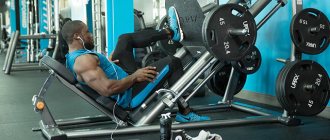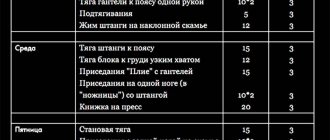Hello, dear readers!
In this article, I will tell you about a great way to create a beautiful and toned figure - this is a workout program for 5 days a week! It is designed for well-trained sports fans who have already built up muscles and want to look lean. This program is designed to gain muscle mass and definition.
We recommend reading: Bent-overs with a barbell while sitting
Muscles grow as strength increases and strength endurance increases. By conducting separate training for each large muscle group, you can accustom it to a large volume of training load, which will result in muscle growth. In addition, by training 5 times a week you will speed up your metabolism very well. And if you endure a couple of months of working on it, you will acquire excellent relief.
Surely many of you have used three-day splits in your training process. Increasing the frequency of training to five per week gives you a significant advantage - every day you can train one muscle group per workout.
Let's look at a specific example of a training program designed for 5 days a week, which, if necessary, you can adjust to suit you.
Principles of a Mass Gaining Training Program
Gaining muscle mass is the main goal of men who come to the gym. Achievement depends on these factors:
How much to train
The duration of a gym session should not exceed 1 hour. Stay busy longer and you will become overworked and start to burn your muscles. The pause between approaches should last from 1 to 4 minutes, this is enough for recovery. Very long periods of rest can affect the effectiveness of the exercise - the muscles return to their original state before exercise.
How often should you exercise to grow muscles?
There are certain requirements for the rest period between workouts for certain muscle groups - at least 72 hours. Hence the recommended frequency of training is no more than four per week: 3 strength and 1 light recovery.
With each workout, muscle fibers are broken down, vital nutrients are depleted and, of course, fatigue. This results in decreased functionality. From this starting point, your body will repair itself by increasing muscle protein synthesis to repair muscle tissue, returning you to baseline as quickly as possible. If recovery is normal, there is a period of supercompensation during which your functionality exceeds your baseline level. This means that your muscles are growing faster than before.
Basic training
Do you want to become huge? Do a basic training program to gain weight. It is on this basis that you will build bulky muscles so that you can subsequently transform them into relief during training.
“Compound” exercises are called multi-component exercises that train several muscle groups at the same time, while isolation exercises work only one. Start the first training phase (1-3 weeks) with the core exercises - deadlifts, squats and bench press - and then continue with the formation of individual muscle groups in the second phase (4-6 weeks). The program is divided into:
- increasing the volume of the biceps;
- pumping the legs;
- building shoulder muscles;
- back pumping.
At the third stage of gaining muscle mass (7-9 weeks), you can additionally begin detailed work on the trapezius, triceps, forearms and other smaller muscles
Reps and sets for bulking
The optimal range of repetitions of one exercise in a set is 6-12, all approaches should be no more than three. Work in a relaxed manner, focusing on the correct technique. Training to gain muscle mass requires a thoughtful and thorough approach, and neglecting the technique leaves its mark on the speed of achieving results and its quality. Moreover, these are not only the mistakes of beginners, but also of some experienced bodybuilders. Be smarter and work solely for the sake of results.
Free weights
An effective weight training program should definitely include free weights, since it is resistance exercise—with barbells and dumbbells—that promotes active muscle growth. Just don't let your muscles get used to a certain weight, otherwise they will stop growing. Increase your working weight, but remember: you must do it gradually.
Muscle shocking
Make changes to your program every 3-4 weeks so that your muscles don't have time to adapt and become stressed by the unusual workload. You can increase the intensity of your classes, add new exercises, increase the load, etc. Constantly expand your knowledge about methods of influencing the body and pump up your muscles.
Recovery and muscle gain
It may surprise you, but muscle fiber growth occurs not during exercise, but during rest. This means that high-quality muscle hypertrophy can only be achieved by following a recovery regimen. Proper muscle recovery after training is one of the keys to success in your chosen goal.
Protect your muscles from overexertion and give them time to recover. The ideal option is to choose a program that uses one muscle group no more than once a week. This way you gradually work your whole body without overloading.
The key to high-quality weight gain is a training program that is chosen wisely and takes into account the characteristics of your body.
The recommended strength training program is suitable for intermediate to advanced bodybuilders. The training plan is designed for 6-8 weeks.
Who needs to exercise 5 days a week
If you are a beginner, then you don’t need to read the rest of the article. The five-day programs are suitable for intermediate and advanced levels only.
Even experienced athletes often train only 3-4 days a week, and only switch to a 5-day split for 4-6 weeks to solve specific problems.
The goals are the following:
- Gaining total muscle mass
In experienced bodybuilders, the body gradually adapts to regular strength training. This results in a slowdown or complete cessation of muscle growth.
In order to progress further, the training process must regularly “surprise” the muscular system. This is done using various methods of intensifying classes.
One of these ways is more frequent training in a weekly cycle. In this case, the body is divided into 5 parts, and each day is devoted to pumping only one muscle.
- Specialization for a specific muscle group
Many experienced athletes already have a fair amount of overall muscle mass. But every person necessarily has muscles that progress in their development much more slowly than others.
As a result, an imbalance develops when 1-2 muscles are knocked out of the overall picture, spoiling the overall impression of the figure with this lag.
In such a situation, a training program for 5 days a week on the principle of specialization - 1-2 sessions are devoted to intensive training of the lagging muscle group, and on the remaining days other parts of the body are pumped.
- Drying workouts
This is the most common reason for switching to a five-day split.
The more often and longer a person exercises during the drying period, the more he boosts his own metabolism. Therefore, when training for relief, it is customary to switch to more frequent training.
- Strength growth
Again, the five-day strength split is only suitable for the advanced level. If you are a beginner, you will make great progress with three classes a week.
Experienced strength athletes have heavy working weights. And this involves a long warm-up and rest pauses between approaches. As a result, the duration of the workout increases to infinity.
To reduce your overall time in the gym and increase intensity, switch to more frequent classes.
In one training session, only one competitive movement is practiced, instead of the usual 2-3 with a classic three-day split.
Warm-up
Training program for 5 days:
- Stand up straight, tilt your head forward, backward, right, left, and then rotate your head in a circle. Do 5-10 tilts and 10 rotations.
- Rotate back and forth in a circle, first with one hand, then with the other, and finally with both. Keep your arms straight. 10-15 times will be enough.
- Rotate your hands in a circle, first in one direction, then in the other, or clasp your hands together and do all of the above.
- Take an even stance and turn to the right 10 times and to the left the same number. This warms up the back muscles well. And then bend your torso forward, while stretching your arms towards the floor as much as possible.
- Pelvic rotation. Everything is clear here, this exercise also warms up your back, do 15 circular rotations in different directions.
- From a level stand, rise onto your toes and stretch your arms towards the sun, or towards the chandelier. Perform 20 of these lifts.
- Shift your weight onto one leg and rotate the other in clockwise and counterclockwise circles. Also perform 20 rotations with each leg.
- Jump in place 10 times, and then make the exercise more challenging by raising your knees toward your chest as you jump.
- Sit on the surface, straighten your legs and try to fold yourself like a book, reaching your hands towards your heels.
- Remaining in a sitting position, spread your legs to the sides and now stretch your chest towards the floor, hold for 30 seconds.
Five-day split options
A training program for 5 days a week is compiled depending on your goals. Below we will consider the main load distribution schemes on different days.
Split to ground
Option 1 (total muscle mass):
- Monday – chest
- Tuesday – back
- Wednesday – shoulders
- Thursday – hands
- Friday - legs
- Saturday, Sunday – rest
This five-day mass split is a classic example of this type of split. You work out for five days in a row, followed by 2 days of complete rest.
Option 2 (total muscle mass):
- Monday - back
- Tuesday – shoulders
- Wednesday – legs
- Thursday – rest
- Friday - chest
- Saturday - hands
- Sunday – rest
This 5-day muscle-building workout program includes a rest day in the middle of the week and 1 session on the weekend.
If it’s hard mentally and physically to exercise for 5 days in a row, try this option. It is possible that it will suit you better.
Option 3 (specialization in hands):
- Monday – arms (heavy training)
- Tuesday – rest
- Wednesday – chest, back (toning load)
- Thursday – shoulders
- Friday – arms (light training or pumping)
- Saturday – legs
- Sunday – rest
Here all the load and rest is built around the arm muscles. After the first, hard workout, there is a day of proper rest, so as not to interfere with the process of muscle growth.
In this lesson, the emphasis is on working fast (power) muscle fibers.
Next, the chest and back are combined into one toning workout. It should be small both in terms of the weights used and the number of approaches. Again, so as not to interfere with the growth of your arms.
Light (or pump) arm training is needed to pump up intermediate and slow muscle fibers.
Split to dry
During terrain training, the following option is suitable:
- Monday – chest (hard), back (light)
- Tuesday – shoulders
- Wednesday – legs
- Thursday – rest
- Friday – back (hard), chest (light)
- Saturday - hands
- Sunday – rest
In this scheme, the emphasis is on pumping the chest and back (twice a week).
If another part of the body is not dry enough, you can focus on it, and also pump it twice a week to speed up the fat burning process.
Split on strength
This is an approximate version of the powerlifting program for the level of sports training from Master of Sports and above:
- Monday – squats (heavy)
- Tuesday – bench press (light)
- Wednesday – deadlift (heavy)
- Thursday – rest
- Friday – bench press (heavy)
- Saturday – squats (light)
- Sunday – rest
Multi-joint basic exercises
When performing multi-joint basic exercises with heavy weights, the athlete's entire body is subjected to stress. In addition to the muscles of the arms, body and legs, the respiratory and even the central nervous system are involved in the work - this is what provides a significant hormonal response, leading, ultimately, to muscle growth.
It should be noted that the greatest effectiveness for muscle growth is achieved with heavy strength training and performing a low number of repetitions of exercises - no more than 5-7 repetitions. This, in turn, requires not only the use of large working weights and perfect adherence to the correct technique, but also longer rest.
List of basic exercises
The compound exercises are five multi-joint exercises performed with a barbell: the bench press, the standing barbell press, the barbell squat, the bent-over row, and the deadlift. It is these strength exercises that most actively influence the growth of muscle mass and increase the hormonal levels of the body of even a novice athlete.
However, most of the secondary exercises performed with dumbbells or on machines are variations of the basic exercises. For example, a seated dumbbell press or a shoulder press in a machine is a modified standing barbell press. Just like the bench press, it's essentially a variation of push-ups. The only exception is pull-ups.
Deadlift
The deadlift is the number one core exercise for the core. If you do only this and give up any others, you will still see the result in the form of mass gain, since it is the deadlift that involves the maximum number of muscles in the work.
Squats
Barbell squats are a basic exercise for developing leg muscles, from the glutes and quadriceps to the calves. With the correct technique, the spine and abdominal muscles are also included in the work, forming a steel press.
Bench press
The bench press is a key exercise for developing the chest, triceps, and anterior deltoids. Depending on the angle of the bench and the width of the hands on the barbell, it is possible to include various bundles of the pectoral muscle in the work.
Barbell row to the waist
The barbell row is a basic exercise for developing the back muscles and giving it visual width. When performed correctly, the work also includes the deltoids, pectoral muscles, forearms and numerous arm holder muscles.
Standing barbell press
The standing barbell press (also called the “military press”) develops the shoulder girdle, deltoids, arms, improves posture and strengthens the abdominal muscles. It is this basic exercise that creates a classic athletic figure with broad shoulders.
What does the training consist of? 5 basic exercises
5x5 workouts are suitable for all groups of athletes. The main feature of the system is simplicity and efficiency. To build muscle and become stronger, you need to find a barbell, a bench, and master five basic exercises.
1. Back squat: 5 sets of 5 reps.
Photo: istockphoto.com
2. Bench press: 5 sets of 5 reps. 3. Deadlift: 1 set of 5 reps. 4. Standing barbell press: 5 sets of 5 times. 5. Bent-over barbell row: 5 sets of 5 reps.
Rest between sets
The rest time between approaches is on average up to 2 minutes. You should always look at how you feel. When you have a surge of energy and the workout is going well, you can take fewer breaks. If you feel that it’s hard and you need more time to catch your breath and come to your senses, then rest more. But chatting on the phone and discussing who spent the evening with friends is not the best idea for a break between sets. The conversation is guaranteed to take more than 2 minutes – and you won’t even notice it. The effectiveness of training suffers both from insufficient rest and from too long breaks between approaches.
First workout: training the abs and chest
- Cardio machine: 5 minutes.
First superset:
- leg lift in support: 3×10-15;
- Incline crunches: 3×10-15.
- Cardio: 5 minutes.
Second superset:
- wide grip push-ups: 3×10-20;
- lying dumbbell fly with a positive inclination: 3 × 10-15.
- Cardio: 5 minutes.
Third superset:
- bench press on a horizontal bench: 3×10-15;
- pullover lying on a bench: 3×10-15.
- Cardio: 5 minutes.
Number of approaches
I would like to warn you that you should limit your enthusiasm and not exceed the number of approaches in training. Before plunging into the harsh training process, you need to set the limits of the body's training capabilities, determine its individual characteristics, ability to recover from stress, as well as the training intensity necessary for muscle growth. Anything beyond these natural individual limits will lead to overtraining and stagnation.
When performing each approach, a certain amount of force is consumed, and the greater the number of approaches and repetitions, the greater the number. How much energy the body has left for muscle growth depends on its ability to recover
Therefore, it is important that you perform no more sets than the minimum required to stimulate muscle growth
Since we want to reduce the number of exercises required, it is logical to start our experiments with the smallest possible load - with one set. Minimum means, maximum results. And if it is possible to achieve an increase in strength and mass with a minimum of approaches, then this is good. To stimulate growth in muscle strength and size, no more than one approach is required for each exercise and more than two for each muscle group.
Use the pyramid principle with each set: start with low weights and high reps, then gradually increase the weight. At the same time, the number of repetitions that you can perform will decrease; the number of repetitions you can do will decrease. Their total number must correspond to the program recommendations.
The main recommendation for gradually increasing weights relates to warm-up. Start the exercise with 50% of your maximum weight. Do at least 3-4 warm-up approaches as you approach the working weight.
bodybuilding and fitness | www.iron-addicts.com
Author of the program: Sergey Tkachenko (master of sports in bodybuilding, coach)
Difficulty level: high
Goal of the program: mass gain or relief
Number of workouts: five workouts per week
The training program is designed for 1-2 months.
Program objectives:
- Increase muscle volume
- Drawing muscles
- Increased stamina
Method of execution of the plan: Separately, 5 five-day split
- Home workouts without equipment for girls, 2 days a week.
- Home workouts without equipment for men for 2 days a week.
- Running technique | 11 mistakes to avoid | Find out everything!
- Proper nutrition for athletes | 4 harmful myths about nutrition.
- Workouts for Anabolic Steroids | Harsh reality
This program consists of 5 workouts per week, meaning you will perform one muscle group per day.
Perform all exercises one after another, break between exercises for 3-4 minutes. The break between approaches is 2-3 minutes.
In each exercise you will perform 12-15 repetitions, the most important thing is to choose the optimal weight with which you can do everything, and don’t mess around, since your form will depend on the quality of execution of the plan.
Total training time is approximately 1 hour 20 minutes.
You can drink as much water as you like during training.
These 6 Exercises Will Make You Burn
First workout: Legs
Online training program: order the program
- Seated leg extension (4X15)
- Lying leg curl (4X15)
- Lunges (4X15)
- Squats with a barbell on the shoulders (4X10)
- Standing calf raise (3X25)
Second workout: Back
- Pull-ups on the bar (4X15)
- Dips (4x15)
- Bent-over block row (4X15)
- Pull from the top (4X15)
- Shrugs with dumbbells (4X25)
Workout Three: Shoulders
- Bent-over dumbbell swings (4X15)
- Swings with gan. to the sides while standing (4X15)
- Lifting dumbbells in front (4X15)
- Broach (3X12)
- Seated dumbbell press (3x10)
Workout Four: Chest
- Horizontal barbell press (4X15)
- Incline barbell press, top (4X15)
- Incline dumbbell press, top (3X15)
- Dumbbell flyes lying down, incline, top (3X15)
- Dips (3x15)
Fifth workout: arms
- Curling arms with a barbell (4X12-15)
- Seated dumbbell curls (4X12-15)
- Scott Bench Curl (4x15)
- Bending hammer (4X15)
- Arm extension on a block (4X15)
- Bench push-ups from behind (4X12)
- Dips (3X20)
If you need to change the location of the exercises, you can do it; you can change and adjust the program for yourself, depending on your needs.
Massive training program for men | 4 workouts per week
9 Great Cardio Exercises for People Who Hate Running
Related posts:
- Training program for girls in the gym for 3 days
- Fitness program for seven weeks | Be sure to try it!
- Weight Loss Supplements | Here's everything you need to know!
- Push-ups | correct technique
- Massive training program for men | 4 workouts per week
- Training program for men in the gym 2 times a week for weight
Brief description of the 5x5 program
The 5x5 program consists of two complex workouts:
- Workout A: Squats, bench press, bent-over rows
- Workout B: Squats, military press, deadlift
You train three times a week, alternating between workouts A and B, resting at least 1 day in between. Never train 2 days in a row as the body needs rest to get stronger.
Most people train on Monday, Wednesday and Friday. But you can do it on Tuesday, Thursday and Saturday or on Sunday, Tuesday and Thursday. If you work out 3 times a week and rest at least 1 day between 2 workouts, you will build strength.
When starting the 5x5 program, you will start with workout A, and after 2 days do workout B. So, in the first week you train according to the A/B/A scheme, in the second – B/A/B, in the third – A/B /A and so on.
The graph looks like this:
Week 1
| Monday | Wednesday | Friday |
| Squats 5x5 | Squats 5x5 | Squats 5x5 |
| Bench press 5x5 | Army press 5x5 | Bench press 5x5 |
| Bent-over barbell row 5x5 | Deadlift 1x5 | Bent-over barbell row 5x5 |
Week 2
| Monday | Wednesday | Friday |
| Squats 5x5 | Squats 5x5 | Squats 5x5 |
| Army press 5x5 | Bench press 5x5 | Army press 5x5 |
| Deadlift 1x5 | Bent-over barbell row 5x5 | Deadlift 1x5 |
Further, these programs are simply alternated. Everything is very simple.
All repetitions in all sets are performed with the same weight, not counting light warm-up sets.
Your goal is not to achieve a pump or muscle soreness (although this is possible after lifting heavy weights), but to increase the weight each workout. If you perform 5 reps on each set of an exercise, add 5 pounds to the bar next time. For 1x5 deadlifts, add 5kg each time.
Don't start lifting weights that are too heavy right away, or you'll experience pain that could cause you to skip a workout. Start with light weights so your body can adapt to the stress. Remember to add 2.5 kg per workout (30 kg per month) in squats.
If you're doing free weight exercises like squats, bench presses, and deadlifts without breaking form, start with a load equal to 50% of your 5RM. If you have never worked with free weights, haven’t trained for several years, or don’t know what 5RM is, then start with the following loads:
- Squats, bench press, military press: 20kg (empty Olympic bar).
- Deadlift: 40kg (empty Olympic bar + 2 10kg plates)
- Bent-over barbell row: 30kg (empty Olympic bar + 2 5kg plates)
You'll start with heavier weights on your deadlifts and bent-over rows because it's impossible to perform these exercises correctly with an empty bar. With each new repetition, the barbell should touch the floor.
Your first 2 weeks of training in the 5x5 program will look like this:
Week 1
| Monday | Wednesday | Friday |
| Squats 5x5 – 20 kg | Squats 5x5 – 22.5 kg | Squats 5x5 – 25 kg |
| Bench press 5x5 –20 kg | Military press 5x5 – 20 kg | Bench press 5x5 – 22.5 kg |
| Bent-over barbell row 5x5 – 30 kg | Deadlift 1x5 – 40 kg | Bent-over barbell row 5x5 – 32.5 kg |
Week 2
| Monday | Wednesday | Friday |
| Squats 5x5 – 27.5 kg | Squats 5x5 – 30 kg | Squats 5x5 – 32.5 kg |
| Military press 5x5 – 22.5 kg | Bench press 5x5 – 25 kg | Military press 5x5 – 25 kg |
| Deadlift 1x5 – 45 kg | Bent-over barbell row 5x5 – 35 kg | Deadlift 1x5 – 50 kg |
The deadlift uses more muscles than other exercises, so it will take you less time to progress. As soon as you reach 100 kg in working weight, add 2.5 kg to the bar with each workout.
If these weights seem light to you, remember that you will be adding 2.5 kg each workout. This means you will be squatting 50kg in 4 weeks, 80kg in 4 weeks and 100kg in 12 weeks! And all this in 5 sets of 5 repetitions! This weight is much more than most guys use in the gym. Overall, don't forget what's ahead of you.
You won't always gain weight. After a while, it will become difficult for you to complete 5 repetitions. You may not be able to follow the 5x5 protocol. Don't stop - just try again the next time you train. If this doesn't work, don't worry as there are many ways to overcome the plateau
The important thing now is that you just get started!
Explanations for this training program
The above splits are well thought out (i.e. you don’t need to change anything), and accordingly, they do not cause conflicts in the recovery process.
Those. if the split programs were not well thought out, i.e. If, for example, on Monday the chest, on Tuesday the arms, on Wednesday the back, then there would be a conflict in the recovery process.
Those. by training the pectoral muscles, the triceps are also indirectly involved, and the next day you train your arms (the same triceps work again, + fresh biceps), and on Wednesday your back (and on Tuesday you trained your biceps, so now on Wednesday you won’t be able to fully train your back , because your biceps are already tired from Tuesday).
Well, do you understand the point?! The recovery processes are disrupted, but here, in the splits that I have prepared for you, this is not the case. All OK. You have nothing to fear











